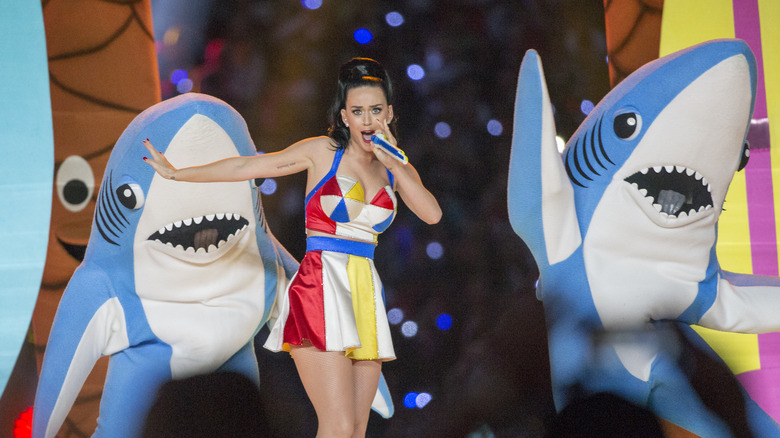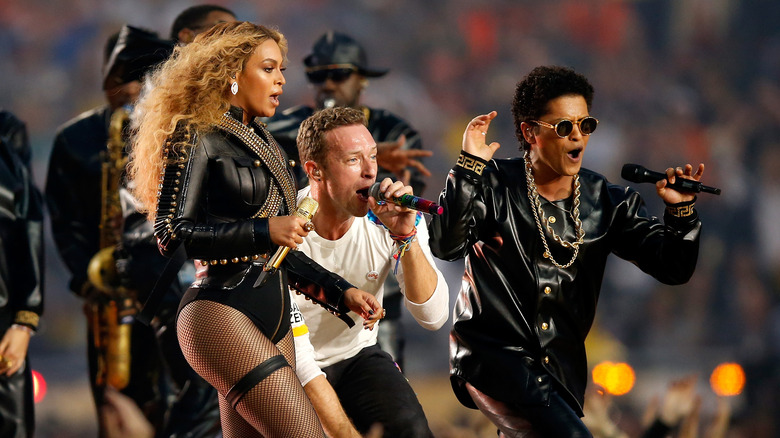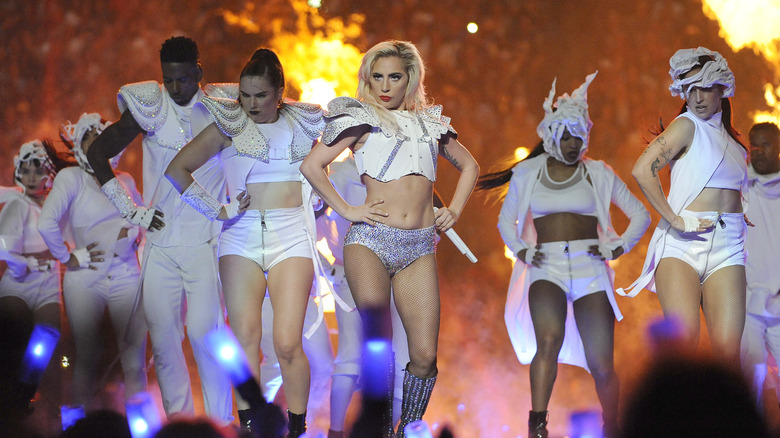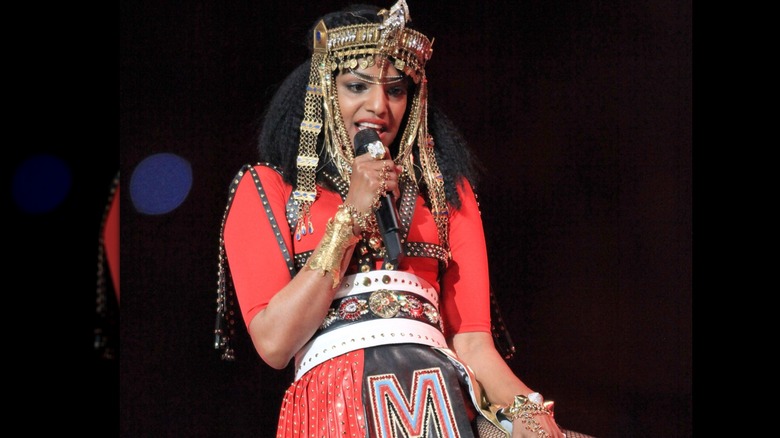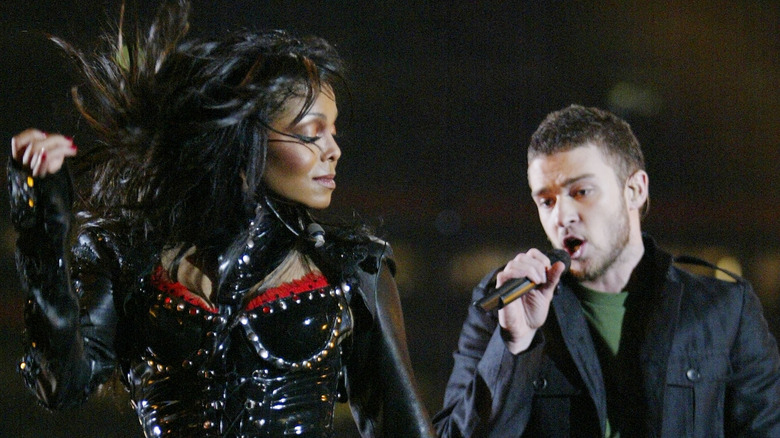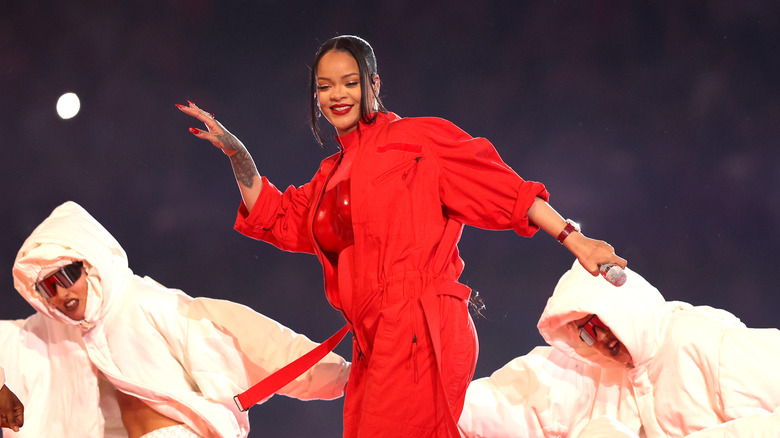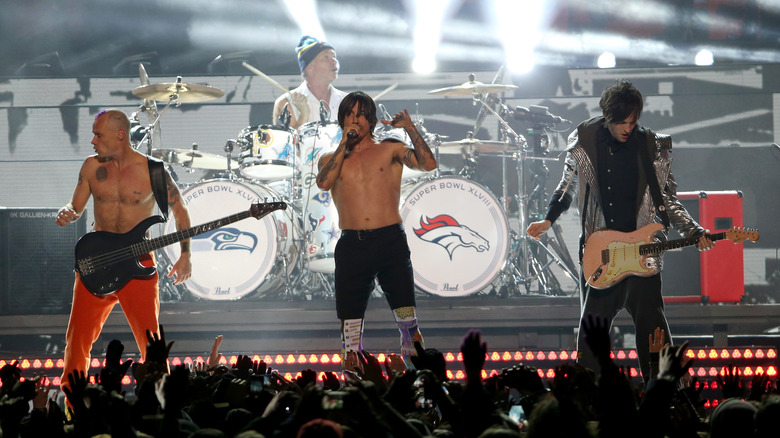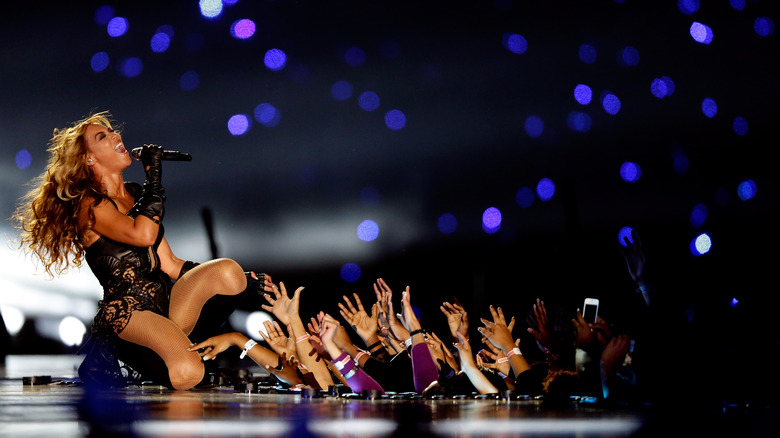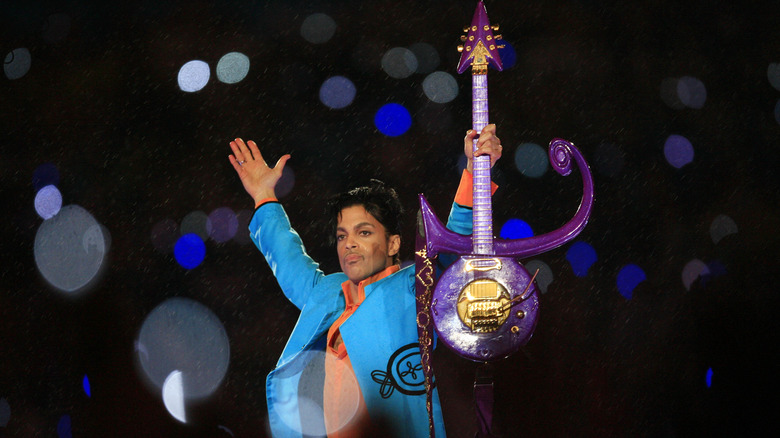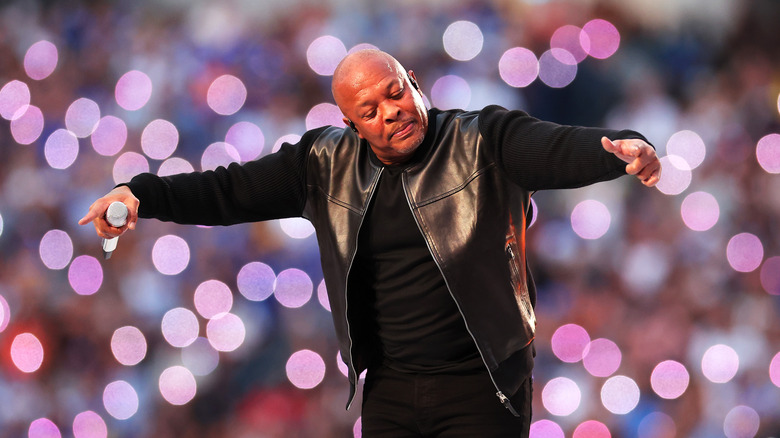Weird Rules Musicians Have To Follow When Performing At The Super Bowl Halftime Show
The Super Bowl is an iconic symbol of American culture and identity. Come game day, a sizable portion of Americans will be huddled around the television — or perhaps buzzing around the snack table — to behold one of the world's biggest and most popular sporting events. If you plan to partake in Super Bowl festivities this year, then you're in good company — the big game is one of America's most-watched broadcasts. In 2022, about 77% of households with televisions turned their dials to the Super Bowl, according to data agency Nielsen.
"The Super Bowl is a cultural event more so than it is a sporting event," sports management expert Brandon Brown told Reuters in 2020. "So you'll have people who are not sports fans whatsoever tuning into the Super Bowl. The NFL has done a really good job embedding itself into the American culture." Of course, there's more to the Super Bowl's cultural appeal than buff ballplayers and iconic commercials. The halftime show is vital to Super Bowl fanfare, with powerhouse performances from the world's biggest celebrities.
For many musicians, playing the halftime show is a career-defining moment. "We all grow up watching the world's biggest acts playing the Super Bowl and one can only dream of being in that position," halftime performer The Weeknd told Time in 2020. But before taking the halftime stage, performers should memorize the playbook for putting on a successful show. Otherwise, they could end up on the losing team.
Super Bowl halftime performers don't get paid
The Super Bowl halftime show is known to feature some of the biggest and brightest stars in music. As such, you might expect the NFL to pay performers a handsome salary for their work. However, that couldn't be farther from the truth. Super Bowl performers aren't paid anything for participating in the halftime show. "We do not pay the artists," an NFL spokesperson confirmed to Forbes in 2016. "We cover expenses and production costs."
That said, halftime performers get plenty of perks, including massive exposure. The Super Bowl isn't just an American staple — it's viewed in over 170 countries, giving performers a unique opportunity to be seen by audiences worldwide. Domestically, there's no bigger broadcast event than the Super Bowl. In 2023, a record-breaking 115.1 million viewers watched the big game. For the halftime act, that's a staggering audience size — not to mention a golden opportunity to reach new fans. In 2014, Bruno Mars' first album saw a 303% increase in popularity following his halftime show. Likewise, pop superstar Shakira scored a 267% boost in digital streams after taking the halftime stage in 2020.
Having the NFL cover your production costs is another major win for prospective halftime acts. According to Forbes, putting on a halftime show costs anywhere from $600,000 to $10 million. For musicians, that means the NFL will foot the bill for you to create the concert of your dreams.
Songs must be shortened for the halftime show
The halftime show isn't just an opportunity for maximum exposure — it's also a chance for artists to showcase the very best of their musical catalog. Typically, Super Bowl artists play a medley of their hits, but each song is considerably shorter than the original version. This method allows the artist to optimize their set list while adhering to the show's narrow time slot. The result is a cornucopia of hits boiled down into about 15 glorious minutes. For many artists, the pressures of creating a Super Bowl performance can be intense. "You're just running around for 13 minutes, trying to put like a two-hour set for 13 minutes," pop goddess Rihanna said at a press event ahead of her halftime performance in 2023 (via Billboard). She added, "That was the hardest, hardest part — deciding how to maximize 13 minutes but also celebrate."
For some artists, the notion of mincing songs could be a dealbreaker. That's precisely what happened in 2004 when hip-hop duo Outkast was invited to perform their hits "The Way You Move" and "Hey Ya" during the illustrious quarter-hour. In 2015, OutKast member Big Boi revealed that his bandmate, Andre 3000, turned the show down after being informed that they'd have to shave some time off the songs. "[Andre] didn't want to cut the songs, he wanted to do the full songs," the rapper dished on "The Dan LeBatard Show" (via Pitchfork). "He said, 'Nah, can't do it.'"
Inappropriate hand gestures can get performers in a lot of trouble
It goes without saying that the halftime show should be a family-friendly event. After all, football is an all-ages sport, and on game day, there are bound to be millions of young eyeballs watching. Therefore, it's no surprise that most artists have opted for uncontroversial halftime shows. Sure, some performances have ruffled feathers (who could forget Jennifer Lopez's iconic "Hustlers"-inspired halftime show in 2020?). Still, for the most part, halftime artists prefer to steer clear of the potential for public backlash.
Aside from reputation damage, there could be legal consequences for offending Super Bowl audiences. In 2012, rapper MIA found this out the hard way when she flashed a middle finger at the cameras during her performance with halftime show headliner Madonna. The gesture spurred hundreds of complaints to the Federal Communications Commission, prompting a public apology from the NFL. Meanwhile, media outlets had a field day with MIA and her audacious middle finger. The NFL responded to the incident by suing the Grammy-nominated musician for $16.6 million. In 2014, the parties settled for an undisclosed amount.
In an interview for NPR's "Morning Edition," the "Paper Planes" rapper claimed that she meant the gesture as a yoga mudra rather than an obscenity. "There's not a lot of them that are named after gods and goddesses," MIA explained. "But the middle finger is specifically named Matangi — the Matangi mudra."
The show's public indecency guidelines are a little one-sided
If you were living in the world in 2004, then you're probably familiar with Janet Jackson's now-infamous wardrobe malfunction. During the Super Bowl XXXVIII halftime show, Jackson was performing with Justin Timberlake when the former *NSYNC member yanked open part of Jackson's corset, revealing her right breast. Jackson's bosom lingered on television for 9/16 of a second — just long enough to trigger a media uproar — before the cameras panned away. Days later, Jackson apologized, and her publicist explained that the wardrobe flub was an accident. "[Timberlake] was supposed to pull away the bustier and leave the red-lace bra," they said (via CNN).
Nudity — intentional or not — is strictly prohibited by the NFL. In this case, it also had legal consequences. CBS and Viacom were sued by the Federal Communications Commission, but the case was eventually dismissed. In 2004, Jackson was banned from the Grammys, and some radio stations boycotted her music.
In 2019, Maroon 5 frontman Adam Levine went shirtless during his halftime performance. Unlike Jackson, he wasn't condemned by the NFL or boycotted by the music industry. In response, critics slammed the NFL and accused the league of appeasing white male performers. "Black women, on the other hand, are demonized for having their nipples shown, even without their consent," a spokesperson for the Women's March said in a statement (via Good Morning America). "It's time the NFL, the entertainment industry, and the nation stop policing and hyper-sexualizing women's bodies."
Performers are allowed to advertise their side hustles
The NFL certainly has a lengthy no-no list for halftime shows, but you might be equally surprised by what performers can do onstage. Apparently, the NFL doesn't feel the need to compete with halftime performers for ad revenue, as evidenced by the fact that artists can market their own products during the show. Not only are ads permitted, but performers can make a fortune from well-executed product placements. Take Rihanna, for example, who used the 2023 halftime show to plug her makeup line, Fenty Beauty. During her performance, the Barbadian pop star reached for a small, pink compact and did a quick touch-up using Fenty Beauty's Invisimatte Blotting Powder. The subtle ad was a massive success for RiRi's beauty brand. Shortly after the performance, Cosmetics Business reported that Google searches for Fenty Beauty shot up 833% (via Forbes). Additionally, the brand saw $5.6 million in earned media.
Companies pay around $7 million to air commercials during the Super Bowl, but Rihanna was able to skirt this enormous price tag by capitalizing on the halftime show's massive audience. Around 115 million viewers witnessed the pop diva's makeup advertisement. Thanks to the brilliant marketing tool, Rihanna turned her halftime moment into serious dollar signs as fans scrambled to get their hands on the blotting powder. #FentyBeauty quickly went viral on social media, adding even more value to an already sweet advertisement deal.
The NFL encourages artists to pretend to play instruments
When running a show like the Super Bowl halftime show, there are dozens of moving parts (think production, dancers, lighting, sound, and so much more). Factor in the live element, and you've got the potential for infinite things to go wrong. Thus, the NFL prefers to mitigate potential crises by having musicians perform along with pre-recorded versions of their set.
In most cases, bands must pantomime rather than play their instruments live. As audio supervisor Mike Stahl told the San Diego Tribune in 2003, set-up must be completed within three and a half minutes, which isn't enough time to prep and test each instrument properly. This "rule" led to an especially memorable moment in 2014: When the Red Hot Chili Peppers took the stage alongside Bruno Mars, the band didn't even bother with plugging in their instruments. (Frontman Anthony Kiedis reportedly still sang live.)
Yes, a number of singers do lip-sync, but that isn't always the case. "Most of the lead vocals are live," audio engineer Patrick Baltzell told The Verge. "Background vocals are always pre-recorded. Most of the band is pre-recorded." While there's been a lot of speculation about who's lip-synced at the halftime show, there have been some notable live performances over the years. The Rolling Stones, for example, played their entire set live — instruments and all — in 2006. In 2013, Beyoncé delivered nothing but live vocals. Katy Perry, who headlined the show in 2015, apparently lip-synced only during her stunts.
On game day, performers must be ready to take the stage in six minutes
As big-time touring artists, most Super Bowl halftime performers are pros at navigating chaotic pre-show environments. However, the pressures of hitting the Super Bowl stage are unmatched — and they'll keep even the most seasoned performers on their toes. When the clock runs out on the first half of the game, the musicians and stage crew have very little time to set up the show. How much time, exactly? "Six. Minutes," Patrick Baltzell revealed to The Verge. "From the end of the first half of a football game to the beginning of the halftime show is between six and seven minutes." To ensure the best show possible, musical acts need to be ready for the stage within that intimidatingly short window. That's six minutes to finish suiting up, take their place, and deal with any pre-show jitters.
During that six-minute window, hundreds of crew members rush to the field and put together the entire stage. The cherry on top comes when the performer enters the stage and belts out the first note of their performance. Between the artist and crew, pulling off a Super Bowl show truly is a team effort. However, the most visible measure of success is how well the performance is received — and that depends on the performer. "Six minutes on and six minutes off the stage," an NFL executive told Popular Mechanics. "There's just no way to describe that other than sheer terror."
The show must go on, regardless of weather conditions
When an artist is under contract with the NFL, they'd better be ready to bring the energy, rain or shine. As far as weather conditions go, the Super Bowl has a relatively fortuitous history, but there's one glaring exception. In 2007, Prince was preparing for his halftime gig in Miami when a turbulent rainstorm hit.
The rain sent executives and show-runners into a state of panic, agonizing over the dangers of damp wires and slippery surfaces. Fortunately, the "Purple Rain" singer brought his signature artistry and vision to the halftime performance, and the outcome was legendary. Despite the weather, the pop icon stayed committed to every detail of his live show. When executives offered him the chance to lip-sync, he purportedly replied, "I'm Prince, I'm gonna play live" (via The Ringer). The music maker rocked the arena while raindrops pelted the stage and puddles formed at his feet — and somehow, the stormy backdrop made everything seem more ethereal.
Even the crew was mesmerized by Prince's halftime show. "So the fact that he performed in this torrential rainstorm, I give him so much credit," Patrick Baltzell gushed to The Verge. "That's my favorite halftime show because it was almost prophetic. We see this lightning bolt start the show, and it was a lightning storm on the night of the show, and the fact that he said 'Rain? I don't care. Bring it on.'"
The NFL balks at controversial political statements
The Super Bowl is an intrinsic part of American society, so it's no surprise that some musicians see the halftime show as an opportunity to weigh in on current affairs. But according to NFL bigwigs, controversial political statements are highly discouraged — and they could even get you censored. "What we say to every artist, very clearly, and they all buy in: the Super Bowl halftime is the biggest musical event of the year, and it's also a communal event for fans," NFL executive Mark Quenzel told Billboard. "Anything that detracts from that is not something that we should be focusing on."
That said, if an artist chooses to make a political statement, they can expect rigorous pushback from the NFL. That's what happened to Dr. Dre when he played the 2022 halftime show. The NFL balked at some of Dre's lyrics — notably, the line "Still f***ing with the beats, still not loving police" from "Still D.R.E." Ultimately, the rapper and business mogul — who spent $7 million of his own money on the halftime show — ignored the NFL's concerns and recited the lyrics anyway. And he wasn't the only rule-breaker that day: Eminem, the Super Bowl halftime show's headliner, also disobeyed the NFL when he kneeled for several minutes during his performance. The gesture, popularized by former NFL quarterback Colin Kaepernick, is an act of protest against racism and police brutality.
